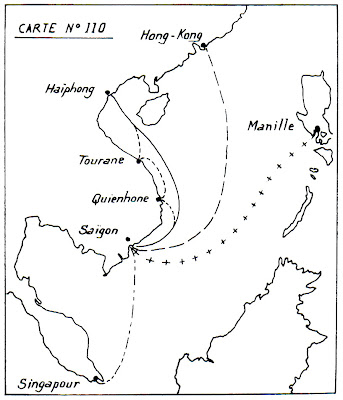FRENCH PAQUEBOTS CANCEL ON "RECARGO DE CONSUMOS - HABILITADO" REVENUE ON 2-CENTAVOS TELEGRAPH STAMP
"MANILLE A SAIGON PAQ. FR."
16 AUGUST 1889
(VERY SCARCE POSTAL USAGE OF THIS REVENUE)
This is a very scarce example of the RECARGO DE CONSUMOS HABILITADO revenue surcharge on a pair of TELEGRAFOS 2-centavos stamps used as postage for the "LIGNES COLONIALES" French Paquebots from Manila to Saigon, Indochina.
From Arnold H. Warren's "Unpublished Studies on Philippine Revenues" (from "The Philippine Philatelist" website), on December 21, 1887, the Philippine Governor General ordered 2,900,000 stamps of various kinds to be surcharged “RECARGO DE CONSUMOS -- HABILITADO” (Surtax For Consumption — Made Valid), with new values, for the collection of the new surtax of five percent on the personal cedulas (poll tax receipts) during the first semestre of 1888 only.
Hence, after June 5, 1888, there was no further need for the “RECARGO DE CONSUMOS -- HABILITADO” stamps, since the amount of the surtax was later included in the price printed on the face of all cedulas issued from July 1, 1888, to December 31, 1889.
Since there were so many of these surcharged stamps left over and no longer needed for their original purpose, decrees issued on January 29 and March 30, 1889, stated that the remaining 1,858,291 stamps be used for postal and telegraph use at the value surcharged on them. A decree by the Philippine Governor General stated that stamps with the surcharge HABILITADO would only be allowed for the franking of letters and telegrams until August 10, 1889.
As a result, F.L. Palmer (1912) indicates that these stamps were available for postal use from January 29 to August 10, 1889. Postally used examples of these “RECARGO DE CONSUMOS -- HABILITADO” stamps are scarce, although "cancelled-to-order" stamps are commonly found.
From "LA POSTE MARITIME FRANCAISE, TOME V" by Raymond Salles (Paris, 1966), the scarce postal cancellation on the stamps pictured above indicates their usage on the "LIGNES COLONIALES" French Paquebots which travelled from Manila to Saigon, Indochina. This French Colonial shipping line was based at Saigon and also had regular stops at Singapore, Quienhone, Tourane, Haiphong, and Hong Kong.
(Map from SALLES, Raymond, "LA POSTE MARITIME FRANCAISE, TOME V, LES PAQUEBOTS DE L'EXTREME-ORIENT", 1966, 1993)
On the date these stamps were used (August 16, 1889), the French LIGNES COLONIALES used the ship "ARETHUSE" on the Manila and Saigon route. "ARETHUSE" was a veteran of the French North African shipping lines, and began her service in May 1885 along the Manila and Tonkin routes, serving between 1885 and 1898.
The stamps pictured above are also interesting in that they appear to have the denomination of $0'02 4/3 on them. F.L. Palmer (1912) lists this surcharge variety as "Type V" and states "due to blurred printing or injury to the die, the 8 of 4/8 often appears to be a 3, making the value read $0'02 4/3".
The Recargo de Consumos surtax was abolished, effective on January 1, 1890, by the Royal Decree of October 25, 1889.





















































